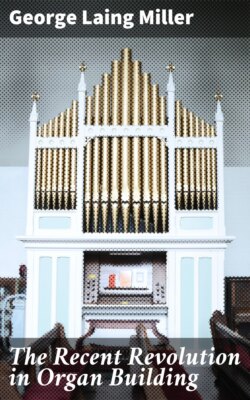Читать книгу The Recent Revolution in Organ Building - George Laing Miller - Страница 8
На сайте Литреса книга снята с продажи.
Pre-historic Double Flutes. From Assyrian and Egyptian Tombs
ОглавлениеTable of Contents
On the other hand we have the syrinx or Pan's-pipes. Stainer says this was undoubtedly the precursor of the organ. "It was formed of seven, eight or nine short hollow reeds, fixed together by wax, and cut in graduated lengths so as to produce a musical scale. The lower ends of the reeds were closed and the upper open and on a level, so that the mouth could easily pass from one pipe to another." This is the instrument used at the present day by the Punch and Judy man. He wears it fastened around his throat, turning his head from side to side as he blows, while with his hands he beats a drum.
The next step would be to combine a set of flutes or shepherd's pipes with the wind reservoir of the bagpipes, placing a little slider under the mouthpiece of each pipe which could be opened or closed at will, so that they would not all speak at once. Then some genius steadied the wind pressure by pumping air into a reservoir partly filled with water. This was the so-called "hydraulic organ," which name has given rise to the impression that the pipes were played by the water passing through them—which is impossible.
And so we come down the ages to the Christian era. The Talmud mentions an organ (magrepha) having ten pipes played by a keyboard as being in existence in the Second Century. "Aldhelm (who died AD 709) mentions an organ which had gilt pipes. An organ having leaden pipes was placed in the Church of S. Corneille, at Compiegne, in the middle of the Eighth Century." St. Dunstan had an organ with pipes made of brass. Then we have the organ in Winchester Cathedral, England, described by Wulfstan of Winchester in his "Life of Saint Swithin." This was a double organ, requiring two organists to play it. It contained 400 pipes and had thirteen pairs of bellows. It was intended to be heard all over Winchester in honor of St. Peter, to whom the Cathedral was dedicated.
The year was now AD 951, and this is an important date to remember, as modern harmony took its rise about this time. Before this, as far as we know, there had been no harmony beyond a drone bass, and the vast companies of musicians described in Holy Writ and elsewhere must have played and sung in octaves and unison. I quote Stainer again:
"The large pipes of every key of the oldest organs stood in front; the whole instrument sounded and shrieked in a harsh and loud manner. The keyboard had eleven, twelve, even thirteen keys in diatonic succession without semitones. It was impossible to get anything else than a choral melody for one voice only on such an organ * * * the breadth of a keyboard containing nine keys extended to three-quarters the length of a yard, that of the single key amounted to three inches * * * even from five to six inches * * * The valves of the keys and the whole mechanism being clumsy, playing with the finger was not to be thought of, but the keys were obliged to be struck with the clenched fist, and the organist was often called 'pulsator organum' (organ beater)."
Gradually the keys were reduced in size and the semitones were added. By 1499 they had almost reached the present normal proportions. In 1470 pedals were invented by Bernard, the German, a skilful musician of Venice, the pipe work was improved and so we come to the Sixteenth Century[1] after which the organ remained almost in statu quo for hundreds of years.
Since then there have been four great landmarks in organ construction, viz:
1. The invention of the swell box by Jordan in 1713;
2. The invention of the horizontal bellows, by Samuel Green, in 1789;
3. The invention of the pneumatic lever by Barker in 1832; and the electro-pneumatic action, by Péschard in 1866; and,
4. The marvelous improvements in mechanism and tone production and control in 1886 to 1913 by Robt. Hope-Jones.
[1] The organ compositions of Frescobaldi, a celebrated Italian organist who flourished 1591–1640, show that the organ must in his time have been playable by the fingers.
